Palazzo Medici-Riccardi, Florence, Italy.
The chapel, in the first floor of the Medicis private residence, was
built by Michelozzo (1396-1472) between 1446 and 1449 and dedicated to
the Holy Trinity. It comprises an almost square main room and, one step
higher, an equally nearly square chancel. The two are separated from each
other by two Corinthian pillars.
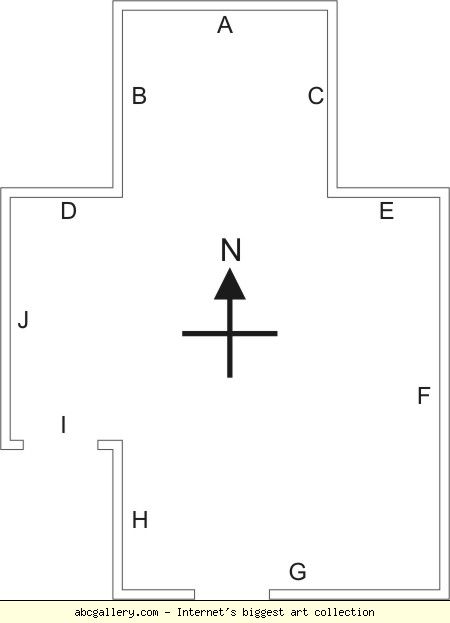
| A |
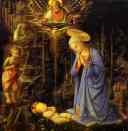
|
Fra Filippo Lippi. The Adoration, with the Infant
Baptist and St. Bernard. c.1459. Tempera on panel. Gemaldegalerie,
Berlin, Germany.
The Fra Filippo Lippi's original (in Staatliche Gemaldegalerie, Berlin,
now) was replaced with a copy in 1494. In the Gemaldegalerie, the painting
is identified as The Adoration, with the Infant Baptist and St. Bernard.
There is also an opinion that the painting shows the Holy Trinity and as
the chapel was dedicated to the Holy Trinity, this seems more appropriate |
| B |

|
Angels Worshipping. 1459-1461. Fresco.
Left side of the chancel, Palazzo Medici-Riccardi, Florence, Italy. |
| C |

|
Angels Worshipping. 1459-1461. Fresco.
Right side of the chancel, Palazzo Medici-Riccardi, Florence, Italy. |
| D |

|
Vigil of the Shepherds. 1459-1461. Fresco.
Left side of entrance to chancel.Palazzo Medici-Riccardi, Florence, Italy. |
| E |

|
Vigil of the Shepherds. 1459-1461. Fresco.
Right side of entrance to chancel.Palazzo Medici-Riccardi, Florence, Italy. |
| F |
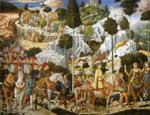
|
Procession of the Magus Balthazar. 1459-1461.
Fresco. East wall of the chapel, Palazzo Medici-Riccardi, Florence, Italy.
The members of the Medici family are depicted among the King's retinue.
At the head of the group, behind Balthazar, rides Piero de' Medici (1416-1469),
who commissioned the frescos. |
| G |
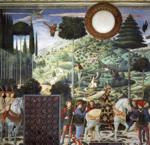
|
Procession of the Magus Melchior. 1459-1461.
Fresco. Soutern entrance wall, Palazzo Medici-Riccardi, Florence, Italy. |
| J |
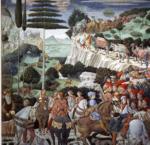
|
Procession of the Magus Caspar. 1459-1461.
Fresco. West wall wall, Palazzo Medici-Riccardi, Florence, Italy. |
In the 17th century, the new owners of the Palazzo Medici, decided to
insert a flight of stairs near the chapel. For this purpose the south westen
corner with the parts of King Melhior and King Caspar frescos was dismantled.
After the stairs were finished, the cut out elements were mounted on the
new wall (H). During all these procedures, the horse of the King
Caspar was cut and mounted on two different segments of the wall. The empty
section of wall above the new door (I) now contains a landscape
in the style of Gozzoli.






